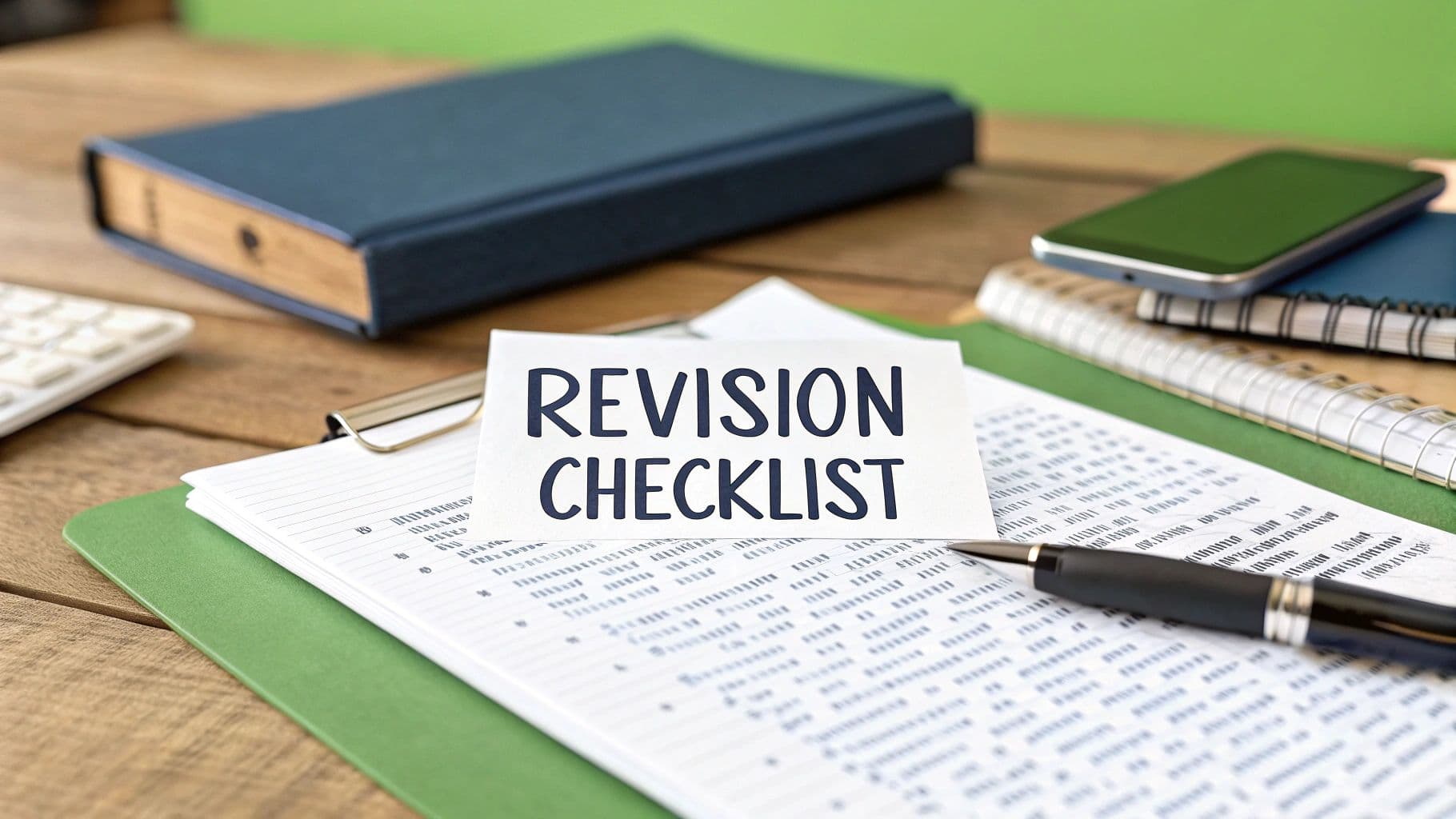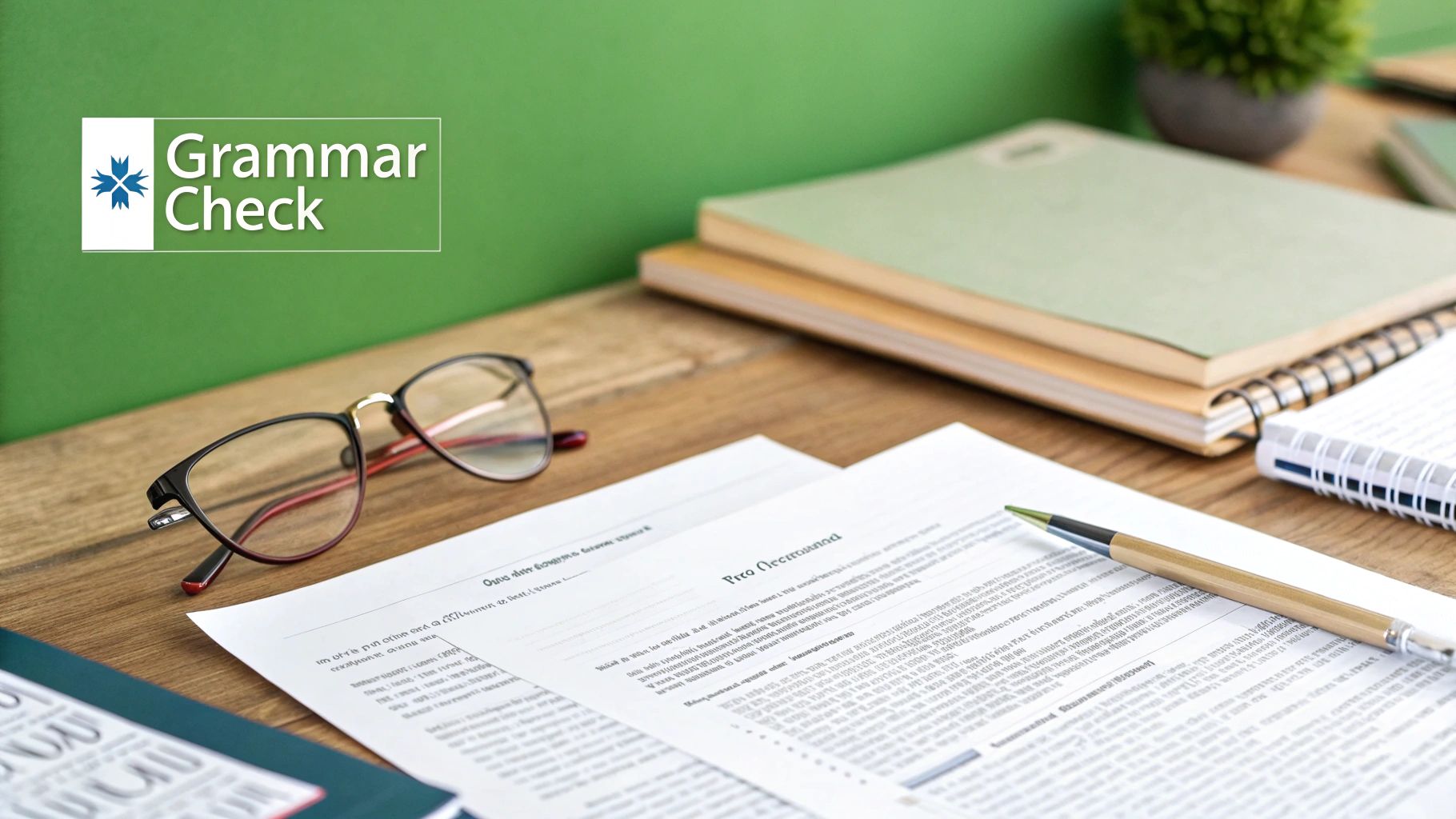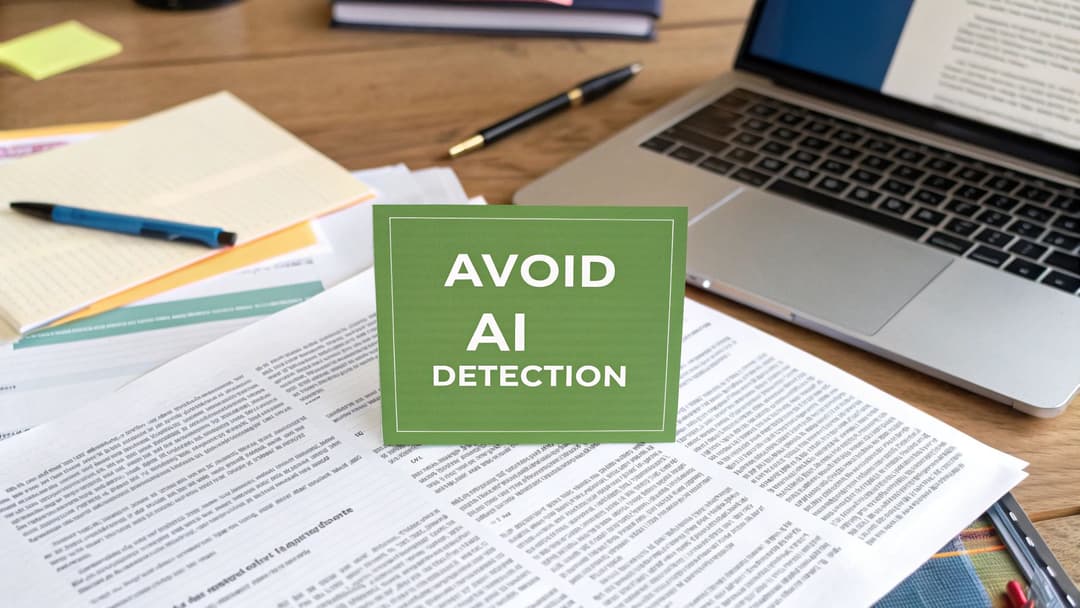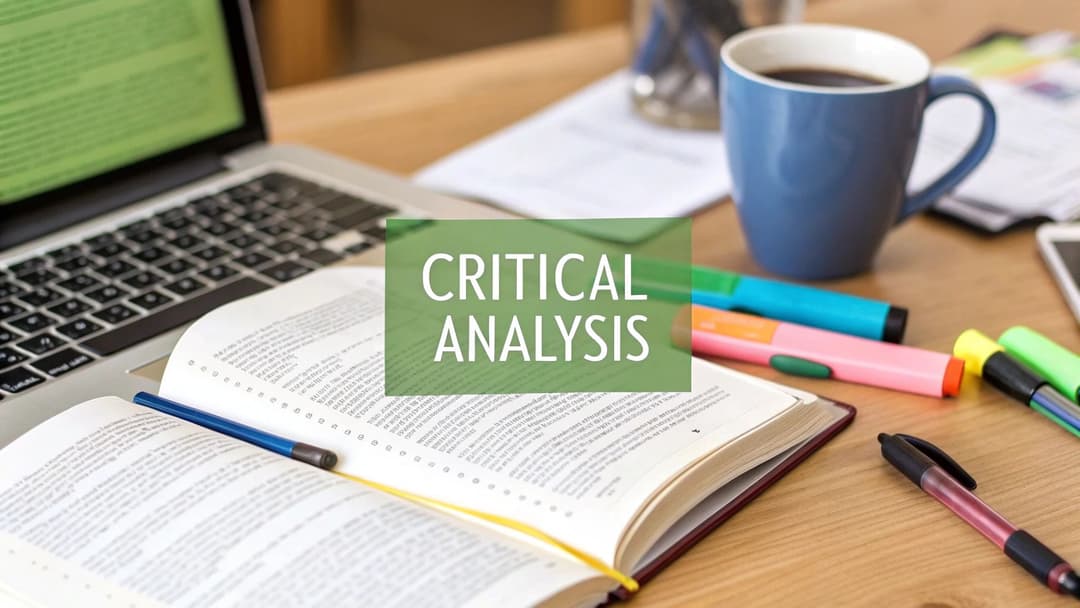
Writing Revision Checklist: 8 Tips to Perfect Your Draft
July 14, 2025
The difference between good writing and truly great writing isn't raw talent-it's a meticulous revision process. In an age of rapid content creation, where AI assistants can generate drafts in seconds, the human touch of a thorough edit has become the ultimate differentiator. A well-executed revision turns a jumble of ideas into a clear, persuasive, and impactful message. But where do you start? It's easy to feel overwhelmed, simply correcting a few typos and calling it a day.
This comprehensive 8-step writing revision checklist provides the structure you need. It guides you through a multi-layered approach, from big-picture structural changes to the finest grammatical details. We’ll cover everything from strengthening your core argument and aligning with your audience's needs to ensuring your voice and tone remain consistent throughout.
By following this plan, you'll not only catch errors but strategically enhance every aspect of your work. You will learn how to systematically review your content, verify your evidence, and apply a final polish that makes your message resonate. This guide helps transform your drafts from merely 'done' to truly exceptional, ensuring your final piece connects authentically with your readers.
1. Step 1: The Macro Edit - Content and Structure Review
Before correcting a single comma or word choice, you must zoom out to see the big picture. The macro edit is a high-level examination of your writing's skeleton: its core message, organization, and logical flow. This foundational step, a crucial first entry in any effective writing revision checklist, ensures your main ideas are clear, your arguments are well-supported, and the entire piece follows a path that serves your audience and purpose.

Ignoring this stage is like decorating a house with unstable foundations. No matter how elegant the prose, the entire structure is at risk of collapse. This initial review is about creating an architectural blueprint for your reader's journey, ensuring every part has a purpose.
How to Implement a Macro Edit
A macro edit involves asking tough questions about your draft's fundamental components.
- Business Reports: A team might reorganize a report to lead with the executive summary and key recommendations, moving detailed data to appendices. This prioritizes the needs of busy stakeholders.
- Academic Papers: A student could realize their thesis statement is weak. The macro edit would involve rewriting the thesis and then restructuring body paragraphs to provide stronger, more relevant evidence.
- Blog Posts: A content writer might reorder a post to follow a clear problem-solution-call-to-action structure, making it more persuasive and easier for readers to follow.
Actionable Tips for Structural Review
To effectively assess your document's structure, try these practical techniques:
- Create a "reverse outline": Read your completed draft and write down the main point of each paragraph. This outline reveals your actual structure, not the one you planned, highlighting gaps in logic or repetitive sections.
- Check the flow: Read only the first sentence of each paragraph in sequence. Do they form a coherent, logical argument? If the narrative feels disjointed, your transitions or paragraph order may need work.
- Question every section: Ask yourself, “Does this paragraph directly support my main thesis or goal?” If the answer is no, the section might need to be revised, moved, or cut entirely.
This strategic approach, popularized by composition theorists like Donald Murray, ensures your writing is built on a solid framework before you invest time in sentence-level polishing.
2. Clarity and Conciseness Check
Once your structure is solid, the next step in any comprehensive writing revision checklist is to zoom in on the sentence level. The clarity and conciseness check is a systematic review focused on eliminating unnecessary complexity, redundancy, and ambiguity. This process ensures every word serves a purpose, making your message direct, powerful, and easily understood by your intended audience.

This stage moves from architectural planning to interior design, polishing the language to be as efficient and impactful as possible. Clear and concise writing respects the reader's time and cognitive energy, ensuring your core ideas are not lost in a sea of jargon or convoluted phrasing.
How to Implement a Clarity and Conciseness Check
This review involves scrutinizing sentence structure and word choice to streamline your message without losing meaning.
- Technical Manuals: A writer could rephrase complex instructions like "The user must initiate the system’s power-down sequence prior to disconnection" into the simpler "Turn off the system before unplugging it." This makes the guide accessible to non-expert consumers.
- Legal Documents: A lawyer might simplify a clause from "Notwithstanding any provisions to the contrary..." to "Despite any other terms..." to ensure a client fully understands the agreement.
- Academic Abstracts: A researcher facing a strict word count can condense "The findings of this study make a suggestion that..." to "This study suggests..." This maintains the academic tone while being more direct.
Actionable Tips for Sharpening Your Prose
To effectively trim the fat from your writing, apply these proven techniques:
- Read sentences aloud: Your ear will catch awkward phrasing, run-on sentences, and unnatural rhythms that your eyes might miss. If it's hard to say, it's probably hard to read.
- Use a readability checker: Tools like Hemingway Editor or Grammarly can instantly highlight overly long sentences, passive voice, and complex words. For more insights on this, you can learn more about how to use a readability checker at naturalwrite.com.
- Strengthen your verbs: Hunt down weak "there is/are" and "it is" constructions and replace them with active, descriptive verbs. For example, change "There are many reasons why the project failed" to "The project failed for many reasons."
- Balance sentence length: Combine short, choppy sentences for a better flow, and break up long, meandering ones to improve comprehension and impact.
This method, championed by the Plain Language Movement and figures like Strunk and White in The Elements of Style, is essential for creating writing that is not just correct, but truly effective.
3. Grammar and Mechanics Inspection
Once your content's structure is solid, the next step in any comprehensive writing revision checklist is to zoom in on the technical details. A grammar and mechanics inspection is a thorough review of grammatical correctness, punctuation accuracy, and spelling. This critical phase ensures your writing is professional, clear, and doesn't distract or confuse readers with errors that can undermine your credibility.

This process is about polishing the surface to reflect the quality of the ideas underneath. Errors like misplaced commas, subject-verb disagreements, or simple typos can create friction for the reader, pulling them out of your narrative and weakening your authority. A clean, error-free document signals care and professionalism.
How to Implement a Grammar and Mechanics Inspection
This technical review requires a shift from a writer's mindset to a proofreader's.
- Academic Journals: A researcher must meticulously follow a style guide like APA or MLA, ensuring every citation, comma, and period is correctly placed to meet rigorous publication standards.
- Business Communications: A marketing team polishes a proposal for a major client, eliminating all grammatical mistakes and typos to project an image of competence and attention to detail.
- Published Books: An author's manuscript undergoes multiple rounds of professional copyediting, where an editor systematically corrects grammar, punctuation, and consistency issues before printing.
Actionable Tips for a Technical Review
To effectively catch technical errors, you need systematic strategies that force you to see your text differently.
- Use grammar software as a first pass: Tools like Grammarly or ProWritingAid can quickly identify common mistakes, but always review their suggestions critically. For a more detailed guide, you can learn more about a self-editing checklist at Natural Write.
- Read backwards, sentence by sentence: This technique isolates each sentence from its context, making it easier to spot grammatical errors, awkward phrasing, and typos you'd otherwise miss.
- Focus on your personal error patterns: Do you often misuse semicolons or struggle with comma splices? Identify your most common mistakes and actively search for them during your review.
- Keep a relevant style guide handy: Whether it's the AP Stylebook for journalism or your company's internal guide, having a reference ensures consistency and accuracy.
This detailed inspection, a cornerstone practice of professional copyeditors and championed by grammar instruction pioneers like Mina Shaughnessy, is what elevates good writing to great writing.
4. Audience and Purpose Alignment
Effective writing is a conversation, and the most crucial part of any conversation is knowing who you are talking to and why. Audience and purpose alignment involves critically evaluating your draft to ensure the tone, language, and content are perfectly tailored to your intended reader and the document's primary goal. This step in the writing revision checklist ensures your message doesn't just get delivered; it gets received, understood, and acted upon.

Writing without this alignment is like giving a lecture on quantum physics to a kindergarten class; the information might be accurate, but it’s completely ineffective. This revision stage is about empathy, strategically shaping your words to connect with your reader's knowledge, expectations, and needs.
How to Implement Audience and Purpose Alignment
This process requires you to step outside your own perspective and view the document through your reader's eyes.
- Medical Information: A hospital's patient-facing brochure on managing diabetes would use simple, empathetic language, focusing on lifestyle tips. The same information written for physicians in a medical journal would use precise clinical terminology, cite studies, and discuss complex treatment protocols.
- Corporate Communications: An internal email announcing a merger to employees will be transparent and reassuring. The external press release about the same merger will be formal, strategic, and focused on market position and shareholder value.
- Educational Materials: A textbook chapter on photosynthesis for middle schoolers uses analogies and colorful diagrams. A university-level version delves into biochemical pathways and molecular structures, assuming significant prior knowledge.
Actionable Tips for Alignment Review
Use these methods to sharpen your focus on audience and purpose:
- Create detailed audience personas: Before you even start revising, define your ideal reader. What is their job? What are their pain points? What is their level of expertise on this topic? Keep this persona in mind during your review.
- Adjust for technicality and tone: Read through your draft specifically looking for jargon or complex language. Ask yourself, “Would my target reader understand this without a dictionary?” Replace overly technical terms with simpler explanations unless you are writing for experts.
- Test content with real readers: If possible, share your draft with a few people who represent your target audience. Their feedback is invaluable for identifying confusing passages, an inappropriate tone, or unmet expectations.
This focus on the reader, a core principle in fields from rhetoric to user experience (UX) writing, transforms your writing from a monologue into a powerful tool of communication.
5. Evidence and Support Verification
After confirming your structure is sound, the next critical step in any comprehensive writing revision checklist is to validate the substance of your arguments. Evidence and support verification is the systematic process of reviewing every factual claim, statistic, citation, and piece of supporting evidence to guarantee accuracy, relevance, and proper attribution. This step is what separates a flimsy opinion piece from a credible, authoritative document.
Neglecting this stage undermines your entire work's credibility. A single incorrect statistic or a misattributed quote can erode reader trust and invalidate your conclusions. This verification process ensures your arguments are built not on assumptions, but on a foundation of verifiable truth, lending weight and authority to your message.
How to Implement Evidence and Support Verification
This process involves a meticulous, detail-oriented review of the data and sources underpinning your writing.
- Journalistic Fact-Checking: News organizations have dedicated departments that verify every claim in a story before publication, from a source's name to a reported statistic, ensuring public trust.
- Academic Peer Review: Scholars submit papers where experts in the field scrutinize the research methods, data, and conclusions, ensuring the study's claims are supported by rigorous and replicable evidence.
- Legal Briefs: Lawyers must cite specific, verified case law and statutes. An inaccurate citation can weaken an argument or even lead to sanctions, making verification an essential part of legal writing.
Actionable Tips for Verifying Support
To effectively validate your evidence and strengthen your writing, try these practical techniques:
- Trace back to the source: Don't just trust a secondary source's reporting of a statistic. Click through until you find the original study or report and verify the numbers and context yourself.
- Cross-reference claims: Use reputable fact-checking websites like PolitiFact, Snopes, or news agency fact-checkers to verify contemporary claims or widely circulated information.
- Keep meticulous records: During the research phase, use a spreadsheet or note-taking app to record the source, link, specific data point, and the date you accessed it. This makes verification much faster.
- Check citation formats: Ensure every citation, whether in APA, MLA, or Chicago style, includes all the necessary elements (author, date, title, etc.) and is formatted correctly.
This rigorous approach, championed by investigative journalism organizations and academic institutions, ensures your writing can withstand scrutiny and is worthy of your reader's confidence.
6. Voice and Tone Consistency
Once your structure is solid and your sentences are clear, the next critical step in a comprehensive writing revision checklist is to evaluate your voice and tone. This is the personality of your writing. Voice is the distinct authorial style, while tone is the attitude you take toward the subject and audience. Ensuring these elements are consistent is crucial for building trust and delivering a coherent message.
Inconsistent tone can be jarring, like a formal business report suddenly shifting into casual slang. It confuses the reader and undermines your authority. This check ensures the "feel" of your document aligns perfectly with its purpose from the first word to the last, creating a seamless and professional experience for your audience.
How to Implement a Voice and Tone Check
Maintaining consistency involves a conscious effort to align stylistic choices with your goals. It's about ensuring every sentence contributes to the same overall character.
- Brand Communications: A marketing team uses a style guide to ensure all blog posts, social media updates, and emails share the same friendly yet authoritative voice, strengthening brand identity.
- Academic Papers: A researcher maintains a formal, objective, and scholarly tone throughout their work, avoiding personal anecdotes or overly emotional language to preserve credibility.
- Personal Blogs: A travel blogger develops a witty and adventurous voice. The revision process would involve removing any sections that sound overly dry or academic, ensuring the entire piece reflects their unique personality.
Actionable Tips for Maintaining Consistency
To effectively audit your writing's voice and tone, use these practical methods:
- Create a voice and tone guide: Before writing, jot down 3-5 adjectives describing your desired voice (e.g., "professional, concise, encouraging"). Refer to this during your revision to check for alignment. For more detailed guidance, learn about establishing brand voice guidelines on naturalwrite.com.
- Read the entire piece aloud: Hearing your words can instantly reveal shifts in tone. A sentence that sounds overly casual or stiff when spoken likely needs adjustment to match the rest of the text.
- Use a consistent vocabulary: Avoid jumping between highly technical jargon and overly simplistic terms. Choose a level of language appropriate for your audience and stick with it.
- Get a second opinion: Ask someone to read your draft and describe the "personality" they perceive. Their feedback is invaluable for spotting inconsistencies you might have missed.
This focus on consistency, championed by brand strategists and creative writing instructors alike, transforms a piece of writing from a simple collection of facts into a cohesive and impactful communication tool.
7. Formatting and Visual Elements Review
Once your content is structurally sound and your prose is polished, the final presentation becomes paramount. The formatting and visual elements review focuses on how your writing looks on the page or screen. This crucial step in any comprehensive writing revision checklist examines layout, typography, spacing, and visual hierarchy to ensure a professional, accessible, and engaging reader experience.
Neglecting this stage is like serving a gourmet meal on a dirty plate; the poor presentation detracts from the quality of the content. Good formatting guides the reader’s eye, emphasizes key information, and makes dense material feel approachable and easy to digest.
How to Implement a Formatting Review
A formatting review means evaluating all non-textual elements that support your message.
- Academic Papers: A graduate student must ensure their manuscript adheres strictly to APA or MLA guidelines, including margins, font, citation style, and table formatting, to meet submission standards.
- Business Reports: A project manager might use bold headings, bulleted lists for key findings, and well-designed charts to make a dense quarterly report scannable for busy executives.
- Web Content: A blogger will check that their post is optimized for mobile readability, with short paragraphs, large fonts, and high-contrast colors, ensuring a good user experience on any device.
Actionable Tips for Visual Polish
To effectively assess your document’s visual presentation, try these practical techniques:
- Use templates and style guides: For recurring documents like reports or newsletters, create a template. For academic or brand work, follow the required style guide meticulously. This ensures consistency and professionalism.
- Check for readability and accessibility: Ensure your font size is legible and there is sufficient color contrast between text and background. This is not just good design; it is essential for readers with visual impairments.
- Test on multiple devices: If your content is digital, view it on a desktop, tablet, and smartphone. A layout that looks great on a large monitor may be unreadable on a small screen.
- Use formatting to create hierarchy: Employ headings, subheadings, bold text, and lists to guide the reader’s attention to the most important points. White space is equally important for preventing visual clutter.
This strategic focus on presentation, championed by web accessibility advocates and professional typographers, ensures your final document is not only well-written but also visually effective.
8. Final Proofreading and Polish
After all the structural, clarity, and stylistic edits, the final proofread is your last line of defense against embarrassing errors. This concluding step in any thorough writing revision checklist involves a meticulous scan for typos, punctuation mistakes, and formatting inconsistencies that slipped through previous passes. It is the final quality control check that separates a professional piece from an amateur one, ensuring your work is presented in its most polished and credible form.
Neglecting this stage can undermine all your hard work. A single misplaced comma or typo can distract the reader, damage your authority, and make your message less effective. This final polish is about respecting your audience enough to deliver a flawless reading experience.
How to Implement a Final Proofread
Proofreading is a focused hunt for surface-level errors, not a time for rewriting sentences.
- Book Manuscripts: Before a manuscript goes to print, a professional proofreader performs a final check against the typeset pages to catch any errors introduced during formatting, ensuring the print version is perfect.
- Legal Documents: A paralegal or lawyer will proofread a contract one last time before it is signed. This prevents costly misunderstandings that could arise from a simple typo or grammatical mistake.
- Marketing Materials: A marketing team reviews a campaign's ad copy, emails, and landing pages immediately before launch to catch any errors that could harm brand reputation or confuse customers.
Actionable Tips for Effective Proofreading
To catch every last error, you need to trick your brain into seeing the text fresh.
- Take a break first: Step away from the document for at least a few hours, or ideally a full day. This mental distance helps you spot mistakes your fatigued brain previously ignored.
- Use text-to-speech software: Have your computer read the text aloud to you. Your ears will often catch awkward phrasing, missed words, or typos that your eyes skim over.
- Change the format: Print the document out or change the font and text size on your screen. Altering the visual presentation forces you to see the words differently and makes errors stand out.
- Read it backward: Start with the last sentence and read your way to the beginning, one sentence at a time. This isolates each sentence from its context, helping you focus purely on the mechanics without getting lost in the flow.
This final check, a standard practice in professional publishing and academic writing centers, is the essential last step that ensures your writing is truly ready for its audience.
8-Point Writing Revision Checklist Comparison
| Review Type | Implementation Complexity 🔄 | Resource Requirements 🔄 | Expected Outcomes 📊 | Ideal Use Cases 💡 | Key Advantages ⭐ |
|---|---|---|---|---|---|
| Content and Structure Review | Medium to High 🔄 | Moderate (time, outside perspective) | Stronger argument, logical flow 📊 | Academic papers, business reports, blog posts | Improves overall coherence and reader engagement ⭐ |
| Clarity and Conciseness Check | High 🔄 | Moderate to High (detailed sentence review) | Clearer, more accessible writing 📊 | Technical manuals, legal documents, academic abstracts | Enhances comprehension and reduces cognitive load ⚡ |
| Grammar and Mechanics Inspection | Medium 🔄 | Moderate (grammar tools, style guides) | Professional, error-free text 📊 | Academic journals, business communications, published books | Maintains credibility and prevents distractions ⭐ |
| Audience and Purpose Alignment | Medium 🔄 | Moderate (audience research) | Targeted, relevant communication 📊 | Medical info, corporate comms, educational materials | Boosts engagement and communication effectiveness ⭐ |
| Evidence and Support Verification | High 🔄 | High (access to sources, fact-checking) | Credible, well-supported arguments 📊 | Journalism, academic research, legal briefs | Builds trust and prevents ethical issues ⭐ |
| Voice and Tone Consistency | Medium 🔄 | Moderate (style guides, reviews) | Cohesive voice, professional tone 📊 | Brand content, academic papers, personal blogs | Strengthens brand identity and reader connection ⭐ |
| Formatting and Visual Elements Review | Medium 🔄 | Moderate (design skills, software) | Professional, readable documents 📊 | Academic papers, business reports, web content | Enhances readability and navigation ⭐ |
| Final Proofreading and Polish | Low to Medium 🔄 | Low to Moderate (fresh perspective) | Error-free, polished text 📊 | Manuscripts, legal docs, marketing materials | Final quality assurance and error elimination ⭐ |
Your Blueprint for Flawless Writing
Navigating the path from a rough first draft to a polished final piece can feel overwhelming. However, by transforming this daunting task into a structured, manageable process, you empower yourself to achieve consistent excellence. This comprehensive writing revision checklist isn't just a list of steps; it's a strategic blueprint designed to guide you from high-level structural assessments all the way down to the final, meticulous polish. Think of it as moving from an architect's blueprint to a master craftsman's finishing touches.
The true power of this method lies in its layered approach. You wouldn’t inspect the paint job on a house before ensuring the foundation is solid. Similarly, you must first confirm your core message is sound (Content and Structure Review) and your arguments are well-supported (Evidence and Support Verification) before you worry about comma splices. This separation of concerns prevents you from wasting precious time perfecting sentences that might be deleted during a structural overhaul.
From Good to Unforgettable
Merely having a correct document is not the end goal. The most impactful writing connects, persuades, and resonates. This is where the finer points of our checklist elevate your work. Aligning your content with your audience's expectations and your primary purpose is non-negotiable. Is your academic paper speaking with authority? Does your marketing copy inspire action?
Maintaining a consistent voice and tone throughout the piece ensures a cohesive and professional reader experience. A sudden shift from a formal tone to a casual one can be jarring and undermine your credibility. By systematically checking each of these elements, from clarity and conciseness to formatting and flow, you build a piece of writing that is not only error-free but also genuinely effective and enjoyable to read.
The Modern Revision Imperative
In an era where AI-assisted writing is becoming commonplace, a final, crucial layer of revision has emerged: humanization. A draft, whether generated by AI or written hastily, can often feel robotic, detached, or generic. Applying this checklist helps you reclaim your authentic voice, infusing the text with nuance, personality, and the subtle rhythms that signal genuine human creation.
Ultimately, mastering the art of revision is about more than just avoiding mistakes. It’s about taking ownership of your message and respecting your reader's time and intelligence. By adopting this structured, multi-pass writing revision checklist, you are investing in a skill that will pay dividends across every aspect of your professional and academic life. You will produce work that not only informs but also influences, leaving a lasting, positive impression.
Ready to take the final, most crucial step in your revision process? If you’ve used AI to generate your first draft, ensure it sounds genuinely human and bypasses detection with Natural Write. Our advanced tool helps you instantly refine robotic text, making your writing more authentic and engaging. Perfect your work with a single click at Natural Write.


